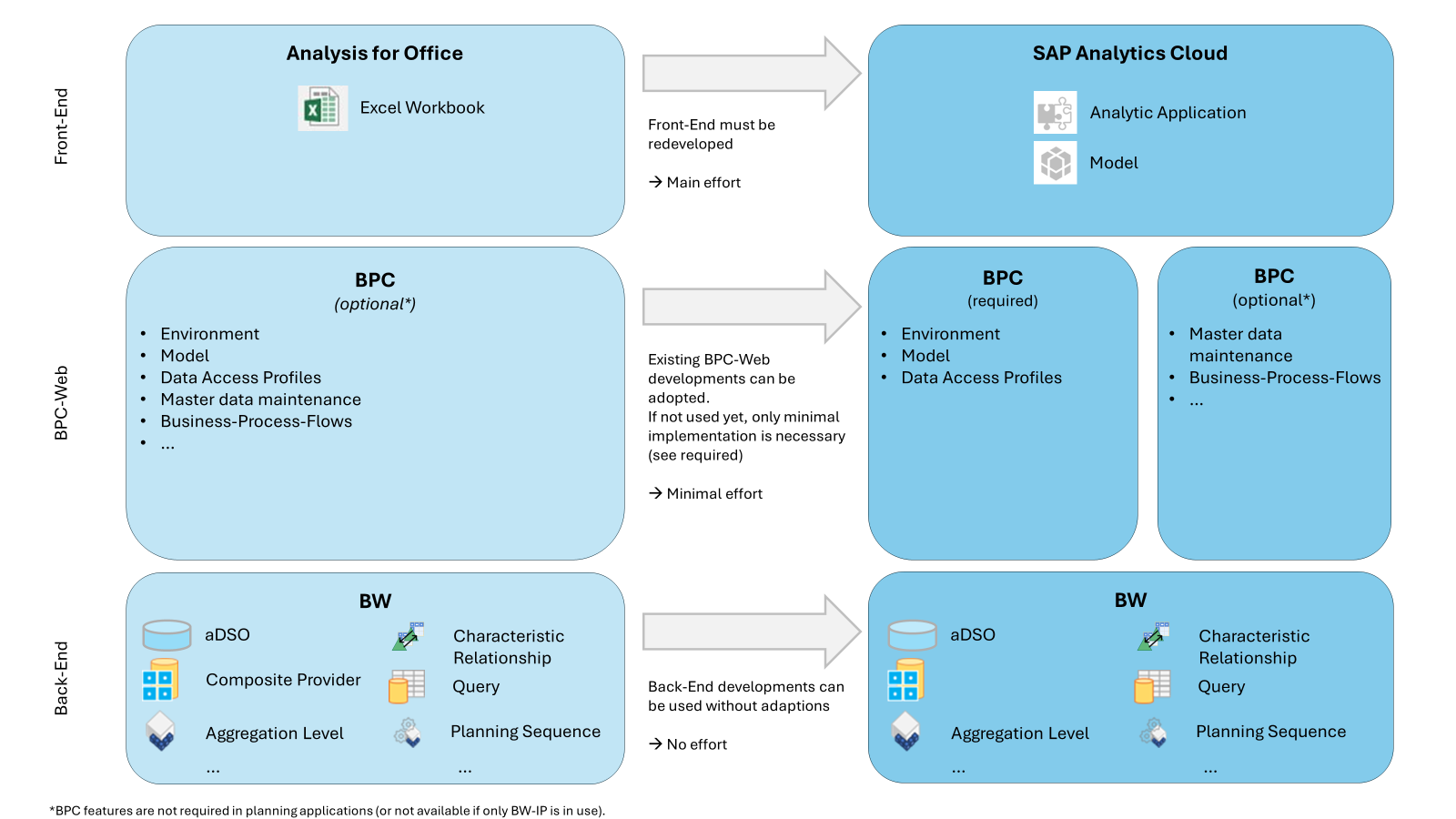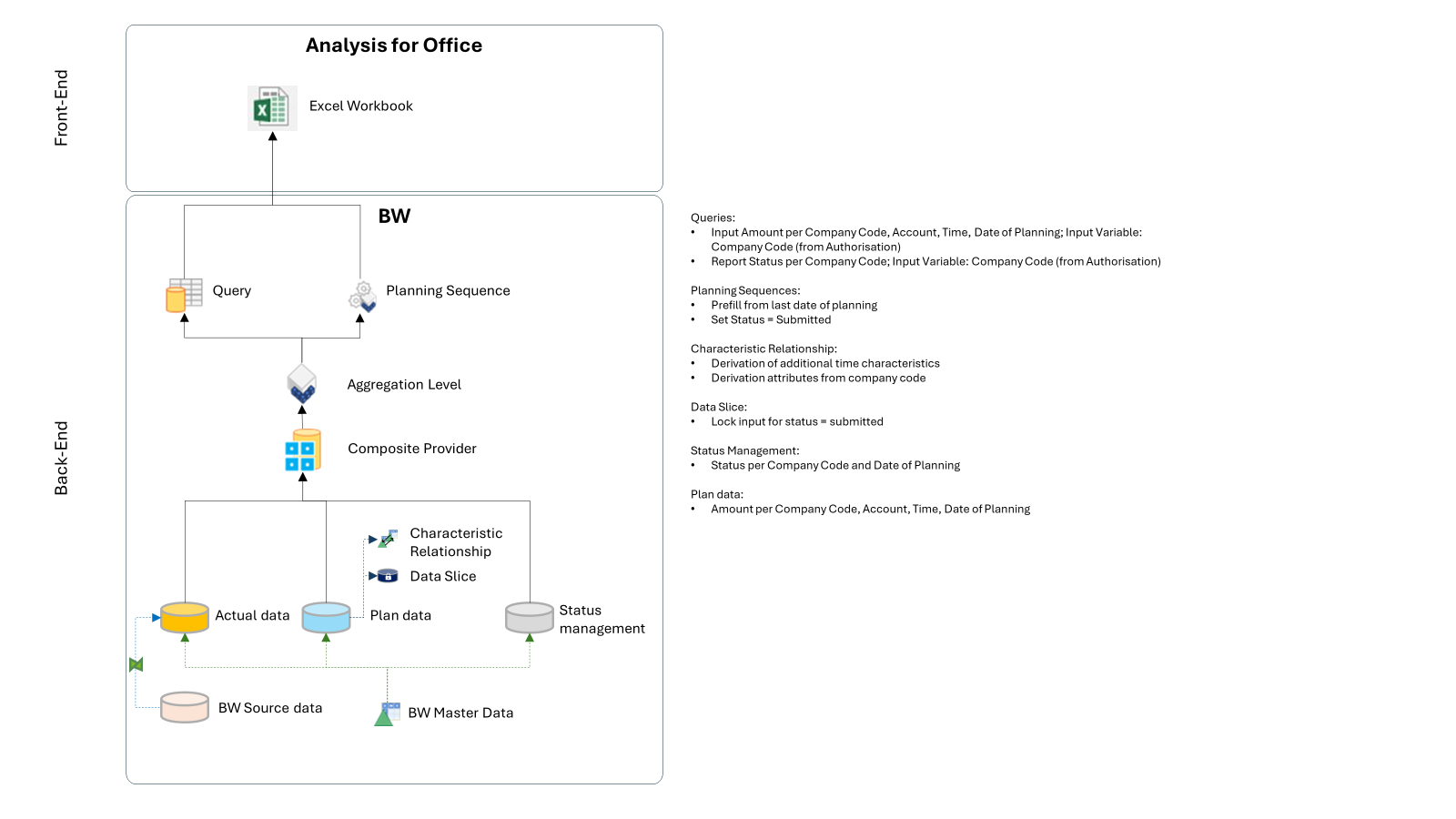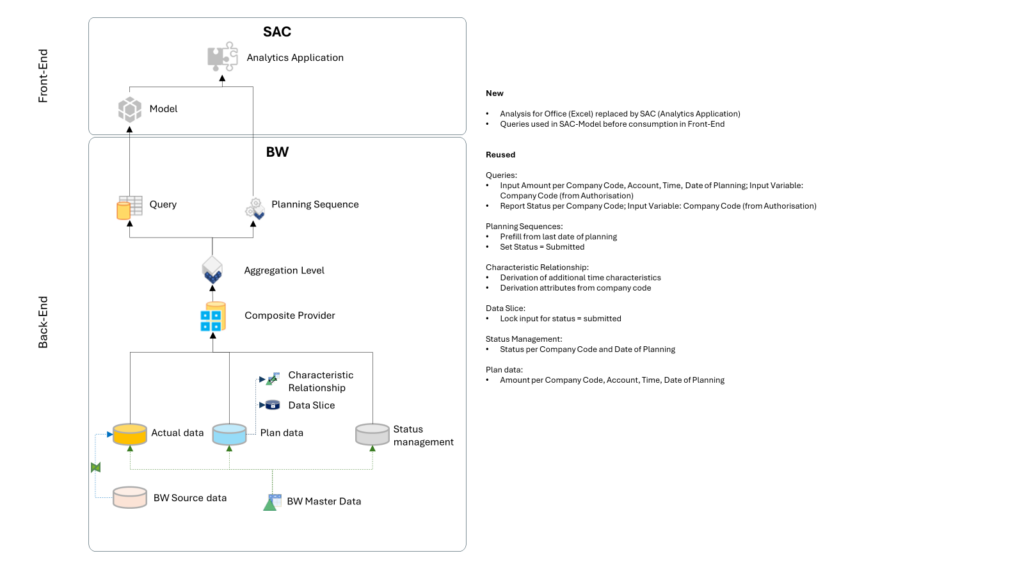Future proof your SAP planning:
BPC / IP transformation to SAC Planning with Live Connection – How and Why
Why change to SAC Planning with BPC live connection? Since more and more customers use SAC for reporting, planning applications are often left behind. But if SAC is in use anyway, there are several reasons to change from BW-IP or BPC (Embedded) to SAC Planning with BPC live connection.
Even if SAC is not in use yet, there are several good reasons to introduce SAP Analytics Cloud (SAC):
- Cloud-based: SAC is a cloud-based solution, which makes it more flexible and accessible as it can be used easier from anywhere (no additional software like “analysis for office” required).
- Modern user experience: SAC offers a modern and engaging user experience with intuitive interface and appealing visualizations.
- Integrated features: SAC provides a wide range of integrated features and support nearly every SAP BW-IP / BPC (embedded) functionality. Mixed modeling with SAC native enlarges the application features even more.
- Protect investments: Investments in back-end development of BW-IP / BPC (embedded) is not lost and can be used in SAC.
- Future-proof: SAP invests in developing SAC and regularly introduces new features and enhancements.
- One Front-End Strategy: SAC only strategy for front-end is only possible if planning is included.
In this blog, I will show, how you can get to SAC live Planning with BPC from your current SAP BW IP or BPC (embedded) applications. This also refers to new planning applications if you need to decide whether you start a new project with BW-IP/BPC or SAC Live Planning. Along the example I will also mention some advantages in comparison to SAC native planning.
Challenges and obstacles in the transformation to SAC
Before we start, let’s look at the biggest challenges and obstacles of a transformation to SAC so that we can classify them correctly and decide if SAC is an option for you.
License costs
Many people are concerned that they will have to pay twice for licensing when planning with SAC Live Connection. Both for SAC Planning and for BPC. That was indeed the case for a while. However, SAP has responded with the “BPC Embedded Access Rights” that avoids double licensing. This new model allows easier and cheaper access. There are a few things to note like:
- The License does not allow the use of Analysis for Office as a client (Analysis for SAC is allowed).
- One full BPC license is required to administrate BPC
- …
All details for the “BPC Embedded Access Rights” can be found here
- https://community.sap.com/t5/technology-blogs-by-sap/introducing-bpc-embedded-access-rights/ba-p/13524670
- https://launchpad.support.sap.com/#/notes/3150518
Missing functionalities
As the SAC is still relatively new, there was a major gap in the available functionalities. However, the SAC is constantly being developed further, so that almost all BW-IP / BPC functions are now available. SAP has summarized the missing functions in the following note:
https://me.sap.com/notes/2969947
From project experience, I can tell that almost everything is possible in SAC live planning. Sometimes it is only necessary to find a different solution that leads to the same result. However, SAC also offers new features that were previously not possible in BW-IP/BPC.
The only relevant disadvantage is the planning of new lines (planning lines). While it is relatively easy to add new rows in Analysis for Office and fill them with copy and paste, this is not possible in SAC. There is also the possibility to add new rows, but it is not possible to insert them by default and also not to edit them with copy & paste.
–> The SAC can currently not be recommended for planning applications that are based on “new lines” or use them on a large scale!
Effort for the transformation
The effort is surprisingly low. Most of the technical changes and therefore also the effort involved are attributable to the new front end. Input masks, reports, etc. must be created in SAC, but even here you don’t start from scratch. Existing queries can be used and keep the effort low. The main effort driver is the quantity and complexity of the front ends to be customized.
In a greenfield approach, I also estimate the effort to be no higher or only minimally higher than for an implementation with BW IP /BPC. To understand this better, let’s look at the following example in the next chapter.
How to get to SAC Live Planning
The migration to SAC will mainly change your front-end. All Back-end development can still be used. This includes all your data modeling and master data as well as planning specific developments like planning functions, data slices or characteristic relationships.
Example – starting point –> target architecture

Besides the new Front-end, a minimum of BPC development is required. This includes:
- BPC environment: Basic BPC namespace in which the development takes place.
- BPC Models: Reference to the BW Back-End InfoProviders in order to be able to use them in the SAC (specification of the used CompositeProvider is sufficient)
- BPC generic Data Access Profile (DAP): In order to avoid the usage of detailed DAPs, it is sufficient to create a single DAP and use the role generated from it in BW in the composite roles, used in BW. This bypasses the BPC DAP concept and you are able to uses the BW authorizations.
- All additional BPC features like master data maintenance, Business Process Flows, Workstatus etc. are optional and can be used (keep missing functionalities in mind).
Since this picture is relatively abstract and only shows a generic way, We will go through the necessary steps in an more detailed example.
Effort – Example
Where do we start
I will try to describe an example planning application. For this example, we start with an SAP BPC embedded application which only used sap BW IP features. However, this is more about describing as many objects as possible, which is why the logic within the planning application is not the focus.
We have a simple liquidity planning in which various companies plan an account structure on a monthly timeline. There is also a separate customized status handling to support the planning process. The following features are in use:
- AfO as Frontend
- Variables / Exit-Variables
- Currency Conversion
- Planning sequences
- Characteristic relation ships
- Data slices
- Custom Status Management
- We don’t use BPC Web client

Backend SAP BW
As mentioned before, there are no adjustment necessary for the backend development. We can use it without any problems. Nevertheless, we need to adjust the authorizations due to the usage of BPC. Since this adjustment is caused by BPC, it will be described there.
Estimation of effort: No effort
BPC Web Client
As BPC is not yet used in our scenario, we must create the necessary parts here.
Environment: An BPC environment hat to be set up once to be able to access the BPC web client functions. Prospective adjustments or new developments can use the same environment.
Estimation of effort: Low effort (<10min)
Necessary action in our example: Create new BPC environment
Model: A BPC model specifies which BW InfoProviders are used and therefore which queries can be used in the SAC. Here it is sufficient to create a model for each planning application that contains all relevant (data-bearing) InfoProviders. CompositeProviders can also be specified here, whereby their basic InfoProviders are automatically added, even if they are added later. For future developments, a new model must be created, or an existing model extended.
Estimation of effort: Low effort (<30min depending on size of data model)
Necessary action in our example: Create new Model with the one Composite Provider
Data Access Profile: We don’t want to use the BPC Authorizations and strictly rely on the BW-Authorizations. To bypass the BPC System, we need to create a single Data Access Profile (DAP). This DAP creates and Role in the BW System, which can then be added to the regular BW-Authorization Roles. For more details on the authorization side, you can also see the blog of my colleague: How to authorize for BPC Planning in SAC – ZPARTNER GmbH
Estimation of effort: Low effort (depending on number of rolls to be adjusted)
Necessary action in our example: Create Data Access Profile; Enhance BW-Authorisations with new role
Frontend – SAC
This is where we need the most effort since the frontend needs to be developed completely new. To consume the existing queries, we need to follow these Steps:
- Create SAC BPC Live Connection
- Create Models: For each Query we must create a SAC Model based on the new live connection. The creation Process is simple, and the final model don’t need further adjustments. We need to Select the Live-Connection, BPC-Environment, BPC-Model and finally the Query. After that we can save the model.
- Create Applications: The Application replaces the former Analysis-For-Office Excel File. Tables (SAC Models based on Queries) and planning sequences must then be inserted in the application. If you completely dispense with an appealing design and additional functionalities, this is done very quickly, and the application is ready for use.
- Tables are customized to achieve a customer-specific design. Length, width, etc. are standardized.
- Planning sequences are placed on „buttons“ and first display a pop-up with a description of the function and the option to „cancel“ before execution.
- For all tables, the most important dimensions are added as filters for end users.
Estimation of effort: Medium-High effort (depending on design requirements)
Result
Our result is almost identical to the original planning solution.

Only the front end has been replaced, which allows us to achieve the advantages mentioned at the beginning of this blog. The effort that had to be invested in this is justified and rewards us with a new and modern front-end.
Conclusion
SAC Planning with BPC live connection is a good way to improve and future proof your current SAP BW IP or BPC Planning applications or even new developed planning applications. Although nearly everything is possible in SAC, make sure to check the current state of missing functionalities and match them with your requirements, before you take any further steps.
The required implementation effort is low. The advantage becomes greater the more backend-development already exists. Nevertheless, the change only makes sense if several of the reasons mentioned at the beginning of the blog speak in favor of it, since a single advantage of the SAC does not necessarily have to be a disadvantage of the current planning and it still works. But if you decide to switch, new applications can also be implemented in SAC without any problems and build on previous know-how.
Front-end development is the main cost driver for the changeover, although there are also advantages here. The SAC is simply the more modern front-end with more appealing and better visualization options (e.g. drill through etc.).
Comparison SAC native
It is also worth making a brief comparison with SAC Native planning. Advantages and disadvantages depend largely on the scenario.
SAC native planning offers some features that are not available in BPC. However, there are also other functions missing in native planning. All in all, BPC is in advantage if a BW is already available, and data is transferred between the planning application and BW. You not only save on interfaces but can also dispense with other administrative activities, such as master data management.
Native planning could be interesting if a new planning application is to be set up that has a new, isolated data model and needs to be implemented as quickly as possible. You can also find further insights into the topic of SAC Native vs. SAC BPC in my colleague’s blog:
Possibility mixed modeling
Besides the advantages/disadvantages between SAC native and SAC live Planning, there is always the possibility to combine both approaches which open up even more possibilities. SAC native planning can be used in precisely those applications in which it has advantages. For example, new small data models which doesn’t exist in BW yet. As there are so many possibilities, it’s up to you to discover the best scenario. The decision to use SAC live planning keeps the options for mixed modeling wide open.